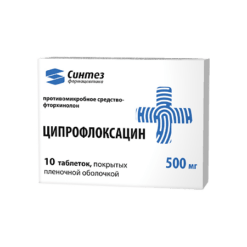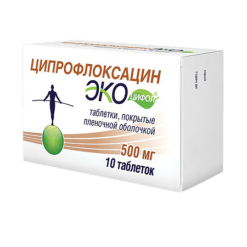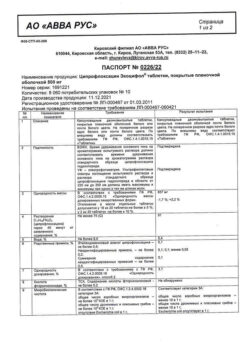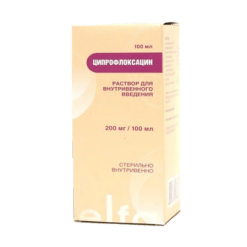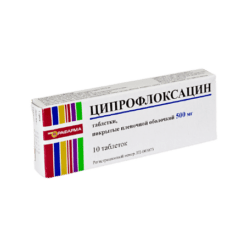No products in the cart.
Ciprofloxacin, 250 mg 10 pcs
€2.13 €1.45
Description
Ciprofloxacin is a broad-spectrum antimicrobial from the group of fluoroquinolones. It has a bactericidal effect. The drug inhibits bacterial enzyme DNA-gyrase, as a result DNA replication and synthesis of bacterial cell proteins are disrupted. Ciprofloxacin acts both on multiplying microorganisms and on those in the quiescent phase.
Ciprofloxacin is susceptible to:
Gram-negative aerobic bacteria: Escherichia coli, Salmonella spp, Shigella spp, Citrobacter spp, Klebsiella spp, Enterobacter spp, Proteus mirabilis, Proteus vulgaris, Serratia marcescens, Hafnia alvei, Edwardsiella tarda, Providencia spp, Morganella mordarii, Vibrio spp, Yersinia spp.
Other Gram-negative bacteria: Haemophilus spp, Pseudomonas aeruginosa, Moraxella catarrhalis, Aeromona, spp, Pasteurella multocida, Plesiomonas shigelloides, Campylobacter jejuni, Neissenia spp.
Some intracellular pathogens: Legionella pneumophila, Brucella spp, Chlamydia trachomatis, Listeria monocytogenes, Mycobacterium tuberculosis, Mycobacterium kansasii, Mycobacterium aviumintracellulare.
Gram-positive aerobic bacteria: Staphylococcus spp. (S.haemolyticus, S.hominis, S.saprophyticus), Streptococcus spp. (St. pyogenes, St. agalactiae).
The sensitivity of bacteria Streptococcus pneumoniae, Enterococcus faecalis is moderate. Most staphylococci resistant to methicillin are also resistant to Ciprofloxacin.
The following bacteria are resistant to the drug: Corynebacterium spp, Bacteroides fragilis, Pseudomonas cepacia, Pseudomonas maltophilia.
Ureaplasma, Clostridium difficile.
The action of the drug against Treponema pallidum has not been studied enough.
Indications
Indications
Infections and inflammatory diseases caused by microorganisms sensitive to Ciprofloxacin:
– Respiratory tract.
– Ear, nose and throat.
– Kidneys and urinary tract.
– Genital organs.
– Digestive system (including mouth, teeth, jaws).
– Gallbladder and biliary tract.
– Skin, mucous membranes and soft tissues.
– Musculoskeletal system.
– Treatment of sepsis and peritonitis.
– Prevention and treatment of infections in patients with reduced immunity (during therapy with immunosuppressants).
Pharmacological effect
Pharmacological effect
Ciprofloxacin is a broad-spectrum antimicrobial drug from the group of fluoroquinolones. Acts bactericidal. The drug inhibits the enzyme DNA gyrase of bacteria, as a result of which DNA replication and the synthesis of cellular proteins of bacteria are disrupted. Ciprofloxacin acts both on microorganisms that are reproducing and those in the resting phase.
Sensitive to Ciprofloxacin:
Gram-negative aerobic bacteria: Escherichia coli, Salmonella spp, Shigella spp, Citrobacter spp, Klebsiella spp, Enterobacter spp, Proteus mirabilis, Proteus vulgaris, Serratia marcescens, Hafnia alvei, Edwardsiella tarda, Providencia spp, Morganella mordarii, Vibrio spp, Yersinia spp.
Other gram-negative bacteria: Haemophilus spp, Pseudomonas aeruginosa, Moraxella catarrhalis, Aeromona spp, Pasteurella multocida, Plesiomonas shigelloides, Campylobacter jejuni, Neissenia spp.
Some intracellular pathogens: Legionella pneumophila, Brucella spp, Chlamydia trachomatis, Listeria monocytogenes, Mycobacterium tuberculosis, Mycobacterium kansasii, Mycobacterium aviumintracellulare.
Gram-positive aerobic bacteria: Staphylococcus spp. (S.haemolyticus, S.hominis, S.saprophyticus), Streptococcus spp. (St. pyogenes, St. agalactiae).
The sensitivity of bacteria Streptococcus pneumoniae and Enterococcus faecalis is moderate. Most staphylococci resistant to methicillin are also resistant to Ciprofloxacin.
The following are resistant to the drug: Corynebacterium spp, Bacteroides fragilis, Pseudomonas cepacia, Pseudomonas maltophilia.
Ureaplasma, Clostridium difficile.
The effect of the drug against Treponema pallidum has not been sufficiently studied.
Special instructions
Special instructions
Patients with epilepsy, a history of seizures, vascular diseases and organic brain damage due to the risk of developing adverse reactions from the central nervous system should be prescribed Ciprofloxacin only for health reasons.
If severe and prolonged diarrhea occurs during or after treatment with Ciprofloxacin, the diagnosis of pseudomembranous colitis should be excluded, which requires immediate discontinuation of the drug and the appointment of appropriate treatment.
If pain occurs in the tendons or when the first signs of tenosynovitis appear, treatment should be stopped due to the fact that isolated cases of inflammation and even tendon rupture have been described during treatment with fluoroquinolones.
During treatment with Ciprofloxacin, it is necessary to ensure a sufficient amount of fluid while maintaining normal diuresis.
During treatment with Ciprofloxacin, contact with direct sunlight should be avoided.
Impact on the ability to drive vehicles and operate machinery: patients taking Ciprofloxacin should be careful when driving a car and engaging in other potentially hazardous activities that require increased attention and speed of psychomotor reactions (especially when consuming alcohol at the same time).
Active ingredient
Active ingredient
Ciprofloxacin
Composition
Composition
1 tablet contains:
Active substances:
ciprofloxacin 0.25 g
Excipients:
cornstarch,
aerosil,
crospovidone,
magnesium stearate.
Shell composition: hydroxypropyl methylcellulose, titanium dioxide, PEG-4000.
Pregnancy
Pregnancy
Contraindicated during pregnancy and breastfeeding.
Contraindications
Contraindications
– Pregnancy.
– Breastfeeding period.
– Children and adolescents up to 18 years of age.
– Hypersensitivity to Ciprofloxacin or other drugs from the fluoroquinolone group.
Side Effects
Side Effects
From the digestive system: nausea, vomiting, diarrhea, abdominal pain, pseudomembranous colitis.
From the central nervous system: headache, dizziness, feeling of fatigue, sleep disorders, nightmares, hallucinations, fainting, visual disturbances.
From the urinary system: crystalluria, interstitial glomerulonephritis, dysuria, polyuria, albuminuria, hematuria, transient increase in serum creatinine.
From the hematopoietic system: eosinophilia, leukopenia, neutropenia, decreased platelet count.
From the cardiovascular system: tachycardia, heart rhythm disturbances, arterial hypotension.
Allergic reactions: skin itching, urticaria, Quincke’s edema, Stevens-Johnson syndrome, arthralgia.
Adverse reactions associated with chemotherapy: candidiasis.
From laboratory parameters: increased activity of liver transaminases, alkaline phosphatase, lactate dehydrogenase, bilirubin, increased concentration of urea, creatinine.
Other: arthralgia; rarely – photosensitivity.
Interaction
Interaction
With the simultaneous use of Ciprofloxacin with didanosine, the absorption of Ciprofloxacin is reduced due to the formation of complexes of Ciprofloxacin with the aluminum and magnesium salts contained in didanosine.
Concomitant use of Ciprofloxacin and theophylline may lead to increased plasma theophylline concentrations due to competitive inhibition at cytochrome P450 binding sites, resulting in an increase in theophylline half-life and an increased risk of theophylline-related toxicity.
Simultaneous use of antacids, as well as drugs containing aluminum, zinc, iron or magnesium ions, can cause a decrease in the absorption of Ciprofloxacin, therefore the interval between the administration of these drugs should be at least 4 hours.
With the simultaneous use of ciprofloxacin and anticoagulants, the bleeding time is prolonged.
With the simultaneous use of ciprofloxacin and cyclosporine, the nephrotoxic effect of the latter increases.
Overdose
Overdose
Treatment: specific antidote is unknown. It is necessary to carefully monitor the patient’s condition, perform gastric lavage, carry out the usual emergency measures, and ensure sufficient fluid intake.
Using hemo- or peritoneal dialysis, only a small (less than 10%) amount of the drug can be removed.
Storage conditions
Storage conditions
Store in a dry place, protected from light, at a temperature not exceeding 25°C.
Shelf life
Shelf life
2 years.
Manufacturer
Manufacturer
Ozon, Russia
Additional information
| Shelf life | 2 years. |
|---|---|
| Conditions of storage | Store in a dry, light-protected place at a temperature not exceeding 25 ° C. |
| Manufacturer | Ozon, Russia |
| Medication form | pills |
| Brand | Ozon |
Other forms…
Related products
Buy Ciprofloxacin, 250 mg 10 pcs with delivery to USA, UK, Europe and over 120 other countries.


